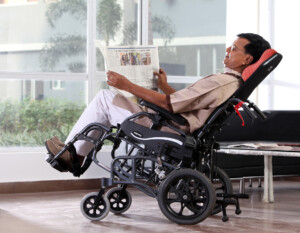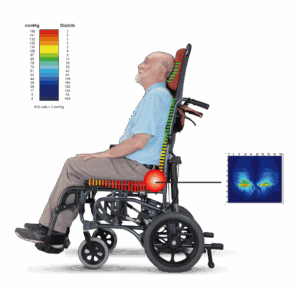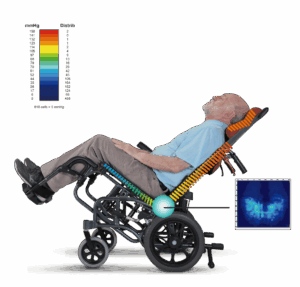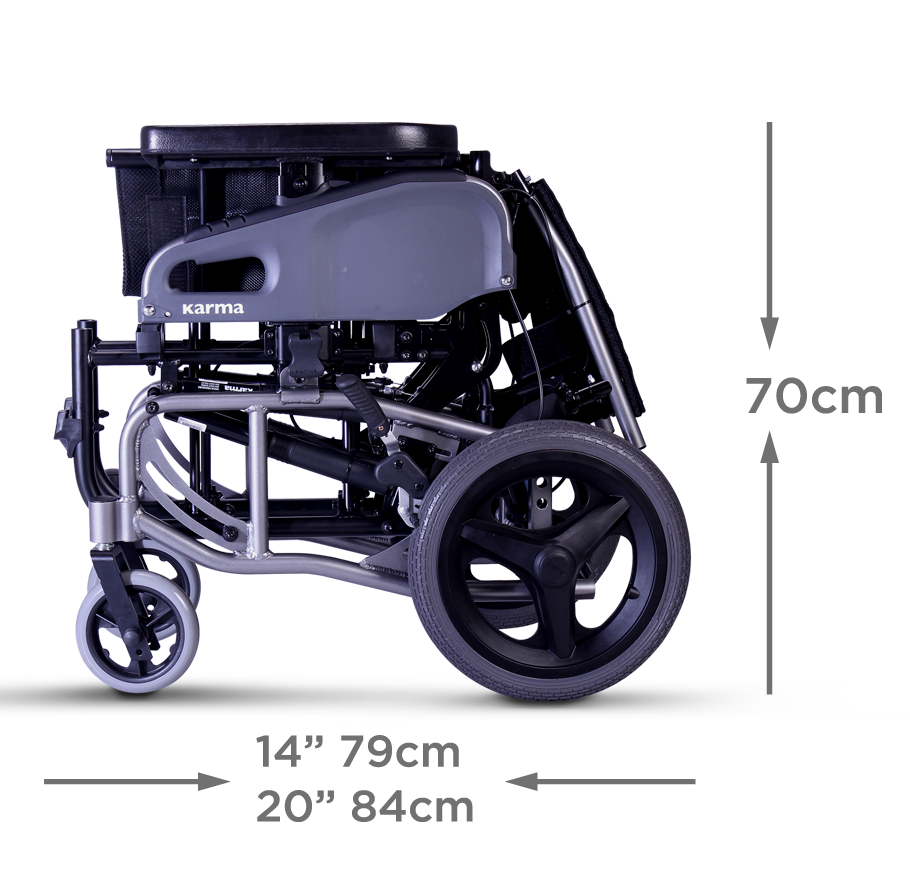For wheelchair users who spend long hours in a wheelchair, one of the biggest concerns is preventing pressure sores and maintaining good posture. Whether caring for a stroke survivor or an elderly with limited mobility, keeping them comfortable and safe can be physically and emotionally demanding. This is a growing concern in Malaysia’s ageing population and long-term care facilities.
This is where tilt-in-space wheelchairs come in. These specialized wheelchairs let you gently adjust a person’s position without bending their hips or knees—reducing the risk of skin breakdown, easing fatigue, and making tasks like feeding or pressure relief much easier.
In this blog, we’ll walk you through what makes a tilt-in-space wheelchair different, how it helps both users and caregivers, and what to consider when choosing one in Malaysia.
Jump straight to:
- What is a Tilt-in-Space Wheelchair?
- Signs Someone May Need a Tilt-in-Space Wheelchair
- Key Benefits of Tilt-in-Space Wheelchairs
- Trade-Offs of Using Tilt-in-Space Wheelchairs
- How to select a Tilt-in-Space Wheelchair in Malaysia
- Tilt-in-Space vs. Reclining Wheelchairs: Key Differences
- Frequently Asked Questions (FAQ)
What is a Tilt-in-Space Wheelchair?
A tilt-in-space wheelchair is designed to tilt the entire seat and backrest backward while keeping the user’s joint angles unchanged. These repositioning shifts pressure from high-risk areas like the buttocks and thighs to the back—minimizing the risk of pressure sores and improving circulation.
Key features often include:
-
Tilt angle adjustments for pressure management
-
Posture support, such as headrests and lateral pads
-
Durable frames for daily, long-term use
Tilt-in-space wheelchairs are ideal for users who can’t reposition themselves—like those with severe strokes, spinal cord injuries, or neuromuscular disorders. For caregivers in Malaysia, tilt-in-space means less physical strain and more time for meaningful care rather than constant repositioning.
Signs Someone May Need a Tilt-in-Space Wheelchair
Difficulty Maintaining Upright Posture
Wheelchair users who frequently lean to one side, slide forward, or can’t maintain a stable seated position may lack proper postural support. Many standard wheelchairs available in Malaysia don’t offer sufficient trunk or head support for those with reduced core strength.
A tilt-in-space wheelchair helps support the body in a natural, stable position, reducing the need for frequent manual repositioning. This makes caregiving tasks like transfers, feeding, and pressure relief easier and safer.
Further Reading:Best Tips to Prevent Elderly Sliding Forward From in a Wheelchair
Frequent Redness or Pressure Sores on The Hips
Repeated redness or early-stage pressure ulcers (bedsores) on the hips, buttocks, or lower back are warning signs that pressure is unevenly distributed. These can quickly worsen if not addressed, affecting the client’s health and comfort.
With a tilt-in-space wheelchair, caregivers can adjust the seating angle to redistribute pressure regularly, reducing the risk of skin breakdown—a common concern in Malaysia’s hot, humid climate.
Persistent Fatigue or Stiffness
Wheelchair users who spend many hours in an ill-fitting wheelchair often experience fatigue and muscle stiffness, which can limit their quality of life. This also increases the physical demands on caregivers.
By promoting better posture and pressure relief, a tilt-in-space wheelchair helps decrease fatigue and stiffness, supporting longer sitting tolerance and easing the caregiving routine.
Key Benefits of Tilt-in-Space Wheelchairs
Tilt-in-space wheelchairs offer important advantages over standard wheelchairs by addressing the key needs of long-term wheelchair users in Malaysia
-
Pressure Management & Skin Protection
The greater the tilt angle, the more effective the pressure relief. At tilt and recline angles over 45 degrees, pressure on the hips is fully shifted to the back, helping prevent pressure sores
-
Improved Postural Control & Stability
Repositioning a user who is slouched can be physically demanding for caregivers. The tilt function leverages gravity to gently reposition users into an upright posture with less effort, reducing caregiver strain and improving patient safety.
-
Enhanced Comfort & Reduced Fatigue
Proper posture supports essential functions like breathing, digestion, and swallowing. Regularly adjusting the tilt angle stimulates blood circulation, relieving pressure points and reducing muscle fatigue
-
Improving Line of Sight and Psychological Well-Being
Stroke patients and others who sit for extended periods often struggle to maintain an upright head position, limiting engagement with their environment. The tilt-in-space feature elevates their line of sight naturally, promoting social interaction, reducing isolation, and boosting confidence—key factors in recovery and quality of life in Malaysian care settings.
Trade-Offs of Using Tilt-in-Space Wheelchairs
Tilt-in-space wheelchairs provide excellent benefits; however, they do come with some considerations to keep in mind, especially for users and caregivers in Malaysia.
These models typically have a higher upfront cost compared to standard wheelchairs. In addition, their size and weight can present challenges for transportation and storage, particularly for those using smaller cars like the Perodua Myvi. Fortunately, innovations like the KARMA VIP515 and VIP2 are designed to be folded and relatively lightweight that fits the needs of long-term wheelchair users in Malaysia.
How to select a Tilt-in-Space Wheelchair in Malaysia
KARMA Fit is our approach to selecting a wheelchair that truly fits the user—not just in size, but in body dimensions, physical ability, daily lifestyle, and budget.
The KARMA VIP515 and VIP2 are especially helpful for long-term wheelchair users in Malaysia who need advanced postural support and pressure management. Here’s a side-by-side comparison to help you decide which one fits your needs:
| Feature | KARMA VIP515 | KARMA VIP2 |
|---|---|---|
| Tilt & Recline Function | Tilt only (35°) | Tilt (36°) + Recline (132°) |
| Seat Size Options (W x D) |
16” x 17”
18” x 17” |
16” x 16”
18” x 18” |
| User’s Physical Function | Suitable for users who can sit but struggle to sit upright independently.
Without reclining function, user’s range of motion on the hip joint is still required. |
Ideal for users with limited mobility who need full back and hip support for longer sitting durations. |
| Lifestyle Compatibility | Indoor & outdoor use | Indoor & outdoor use |
| Malaysia wheelchair price | RM3,299 | RM5,999 |
Tilt-in-Space vs. Reclining Wheelchairs: Key Differences
The most common question we have is what’s the difference between a tilt wheelchair and a reclining wheelchair.
| Feature | Tilt-in-Space | Reclining |
Tilt & Reclining |
|---|---|---|---|
| Suitable User Condition | Users who need frequent pressure relief and stable positioning. | Best for users who can still self-adjust posture and need short-term rest on wheelchair | Suitable for users with severe mobility challenges requiring long-term sitting comfort and advanced posture care. |
| How It Repositions the User | Tilt the entire seat and backrest backward without changing hip angle. | Reclines the backrest while the seat remains flat, changing the hip angle. | Combines both tilt and recline functions for more flexible positioning. |
| Pressure & Skin Protection | Redistributes pressure from the hips to the back without causing shear on the skin. | Reclining can cause shear on the back and shoulders. Some models use biomechanical recline to reduce shear. | Maximizes pressure redistribution while minimizing shear, offering better skin protection. |
| Postural Stability | Uses gravity to support trunk alignment and maintain posture. | May cause sliding, requiring frequent repositioning. | Offers strong postural support and reduces the need for repositioning. |
| Does User Need Hip Joint Flexibility | Yes, because the seat to backrest angle is fixed. | No, caregivers can adjust recline to suit fixed joint conditions. | No, caregivers can adjust recline to suit fixed joint conditions. |
| KARMA model | VIP515 | KM-5000
KM-5001 |
VIP2 |
| Malaysia wheelchair price | RM3300 | RM3100-3300 | RM6000 |
Frequently Asked Questions (FAQ)
- Is a tilt-in-space wheelchair covered by Malaysian welfare or insurance?
Some government assistance programs, such as JKM (Jabatan Kebajikan Masyarakat), may partially subsidize assistive devices based on eligibility. - Can I transport a tilt-in-space wheelchair in a compact car like a Myvi?
KARMA VIP models are foldable and designed for transport. However, due to size, you may need to remove the rear wheels to fit into smaller cars.
Whether your priority is preventing pressure sores, improving posture, or easing daily care routines, a tilt-in-space wheelchair can make a real difference.
When you’re ready to take the next step, explore the KARMA VIP2—our most versatile solution designed with Malaysian users and caregivers in mind.






